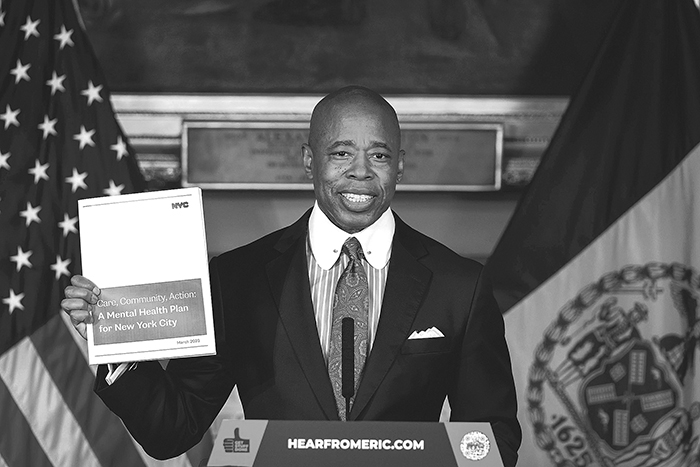Photo Courtesy of Ed Reed/Mayoral Photography Office
Mayor Adams last week launched “Care, Community, Action: A Mental Health Plan for New York City”.
By Forum Staff
Mayor Eric Adams and City Health Commissioner Ashwin Vasan, M.D., recently launched “Care, Community, Action: A Mental Health Plan for New York City,” a mental health agenda — with over $20 million in new commitments — that will, according to Adams and Vasan, invest in child and family mental health, addressing the overdose crisis, and supporting New Yorkers living with serious mental illness (SMI).
While few models of a holistic youth mental health system exist, the long-term benefits of early intervention are potentially greater than with any other group. The need is also becoming clearer, with rates of depression among youth rising. As announced in Mayor Adams’ State of the City address in January, the city will invest $12 million to launch an expansive telehealth program for New York City high school aged teens, connecting them with mental health care. The city will also launch suicide prevention pilot programming at NYC Health + Hospitals for youth entering emergency departments for suicide attempts and community-based suicide prevention programming to specifically serve Black and Brown youth.
The year 2021 was the deadliest year on record for fatal overdoses in the city, with racial and geographic disparities worsening — reflecting trends of the national crisis. To tackle the opioid epidemic, the mental health agenda outlines how the city will expand access to high-quality harm reduction services and sets a goal of reducing overdose deaths by 15 percent by 2025.
To meet this goal, Adams said the City will expand non-fatal overdose response efforts to at least three additional hospital emergency departments and strengthen the 14 syringe-service providers into a network of Harm Reduction Hubs with comprehensive services like a place to rest, addiction services, and medical and mental health services. The City will also expand drug-checking services and implement at least four Public Health Vending Machines that dispense naloxone to increase access in neighborhoods with high rates of overdoses — the first of its kind in the five boroughs. New York will additionally increase support for children, families, and communities affected by the overdose crisis and work to reduce the number of people who develop problematic substance use.
Finally, the City will explore opportunities to expand overdose prevention centers (OPCs) to areas of the city with the highest rates of overdose death, continue to support the two existing OPCs with the goal of allowing them to operate 24 hours per day, and also continue to advocate for legal pathways to fund and operate OPCs.
This plan focuses on connecting New Yorkers with SMI with four pillars of care: health care, housing, community, and crisis response. The city aims to double the number of connections of New Yorkers living with SMI with community-based care over the next four years, putting thousands more New Yorkers on a path to stability. As part of this effort, the city will also expand mobile treatment capacity over the next year to serve 800 more people with high service needs through Intensive Mobile Treatment and Assertive Community Treatment. To expand housing options for people with SMI, the city will add an additional 8,000 units of supportive housing, and invest $7 million more to significantly increase Clubhouse capacity over the next four years.
The mental health agenda additionally outlines how the city will strengthen the crisis response systems, expanding the Behavioral Health Emergency Assistance Response Division (B-HEARD) pilot program citywide to respond to more mental health-related crises with a health-led response and adding two peers to every mobile crisis team to divert people in crisis from unnecessary hospitalizations.

